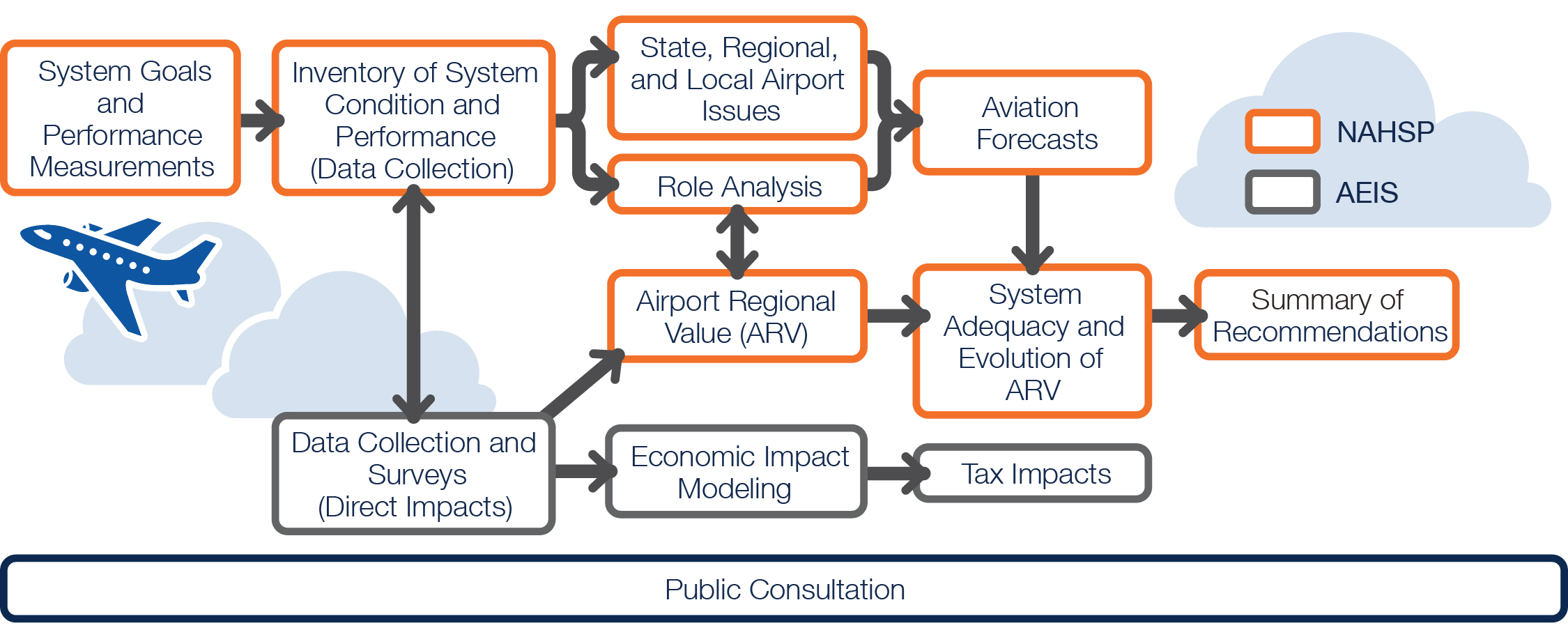Process
The NAHSP and AEIS were conducted simultaneously, with data collection efforts combined for efficiency purposes. The following depicts
the intersection of the two separate efforts and the overall process. For more detailed discussion of each task, see the descriptions below:

NAHSP Task Descriptions
System Goals and Performance Measurements: The NAHSP utilizes the same goals as the OneNevada state transportation plan. By using these same goals, the NAHSP is able to feed into the overall state plan. Along with these goals, the project team also created performance measures as a way to track and analyze the path to achieving the goals set in place.
Public Consultation: Public consultation is critical to gathering relevant and pertinent information and ensuring widespread opportunities for input and feedback. The NAHSP incorporated public feedback through stakeholder interviews; participation of a wide audience in the Planning Advisory Committee (PAC); and through the continued maintenance of this project website.
Inventory of System Condition and Performance: A system-wide inventory was conducted to collect data pertaining to each airport in the study. Data collection was amassed from existing data sources as well as from primary data collected on-site and virtually throughout the study.
State, Regional, and Local Airport Issues: The NAHSP covers numerous issues facing the Nevada aviation industry Some of the topics discussed are:
- Unmanned aerial systems (UAS) and/or unmanned aerial vehicles (UAV)
- Helicopter use, access, and needs
- Tourism and special events
- Fire attack/wildland firefighting
Role Analysis: The FAA’s National Plan of Integrated Airport Systems (NPIAS) identifies nearly 3,400 existing and proposed U.S. airports that are significant to national air transportation and thus eligible to receive Federal grants under the Airport Improvement Program (AIP). Nevada has 30 NPIAS airports and over 130 more airports not in the NPIAS that are both publicly and privately owned and operated. As part of the NAHSP, Nevada airports and heliports are analyzed and categorized considering their function in the state system.
Aviation Forecasts: The NAHSP analyzed user demand and the associated needs to serve the demand. The forecasting process in the NAHSP focused on developing long-term projections that reflect the future need for aviation facilities in terms of based aircraft and operations.
Airport Regional Value (ARV): The ARV is a way to quantifiably evaluate an airport within the Nevada aviation system. Each NPIAS airport was evaluated for factors such as location/access, airport protection, community support, land use, and future capital projects. The non-NPIAS airports were primarily assessed in terms of facilities and services available to the users. The ARV serves as a basis for evaluating potential projects needed at each airport and provide guidance on increasing each airport’s opportunities for growth.
System Adequacy and Evolution of ARV: The system’s adequacy is determined by evaluating performance, starting with existing conditions. While most of the analysis focuses on performance measures and potentially system indicators, additional analyses of service areas, general mobility, and accessibility also factor into evaluating the adequacy of Nevada’s Airport and Heliport System. GIS maps of service areas, population, and other factors were developed to evaluate how the current system is positioned to meet current needs.
Summary of Recommendations: The culmination of all NAHSP task analyses was documented in terms of system needs and associated recommendations. The recommendations include projects necessary for facilities to meet performance measures; recommendations stemming from the state, regional, and local issues; facilities needed to meet objectives; and future studies to be conducted that will provide the Department and/or airports with additional tools.
Deliverables: The NAHSP is intended to have multiple deliverables that can be used by a variety of audiences to understand the analysis, findings, recommendations, and next steps to continue planning and monitoring the Nevada system’s needs. Specific deliverables to be provided include the following:
- Technical Report
- Executive Summary Brochure
- Individual airport brochures
- PowerPoint presentation
The NAHSP compiles all chapters and assembles them into a full Technical Report document that also includes the AEIS, a chapter within the overall document.
AEIS Task Descriptions
Data Collection: Information needed to complete the AEIS was requested in concert with the NAHSP data. A combination of surveys, calls to airports, and in person site visits was used to collect the data. The surveys were used to collect information related to the activity at each airport that contributes to Nevada’s economy and to identify how businesses across the state rely on services provided at Nevada’s public airports.
Economic Impact Modeling: primary data and the IMPLAN model calibrated to regions and to the State of Nevada, the indirect and induced impacts were calculated for each airport. Direct + indirect + induced effects equal total impacts on a statewide basis.
Tax Impacts: The AEIS illustrates local and state tax revenues based on direct effects from the system of Nevada airports.
